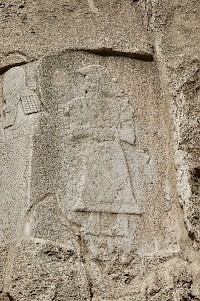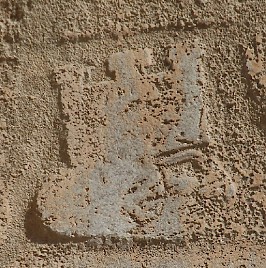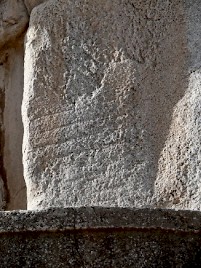Naqš-e Rustam, Elamite relief
Q5952016Naqš-e Rustam: archaeological site in Fars (Iran), best known for its Achaemenid tombs and rock reliefs made in the Sasanian age.
The Elamite Relief

The oldest monument at Naqš-e Rustam is not fully understood but believed to of Elamite in origin. It may date back to the eighth century BCE. The original relief was considerably larger but a very large part of it was later removed when the Sasanian king Bahram II (r.276-293) ordered the making of his audience relief. A small figure with a remarkable cap, vaguely resembling a dwarf, is still visible. This part of the older, Elamite relief is to the right of Bahram's relief.

A second detail is the head of a woman wearing a mural crown, which can still be seen to the left of Bahram's relief. Although the identity of the lady is unknown, her mural crown is a common theme in the art of the ancient Near East. These crowns were usually worn by queens and goddesses, and the lady of Naqš-e Rustam must also be a royal consort or a deity. (Mural crowns would later be introduced into Hellenistic art, would become a Roman decoration, and would finally become part of the western artistic legacy, gracing the coat of arms of countless European cities.)

There is also a much older relief below Bahram's monument, where two gods are visible, seated on a snake-shaped throne. This relief is believed to date back to the seventeenth century BCE, and is, therefore, the most ancient monument of Naqš-e Rustam.
Literature
Louis Vanden Berghe, Reliefs rupestres de l' Iran ancien (1983 Brussels), #18 and 19.